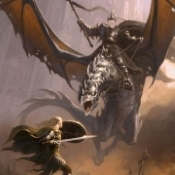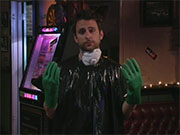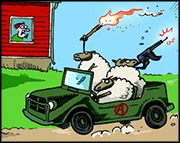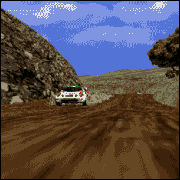|
C2 Because if we just give up on digging deeper and hang out on the surface, why'd we even pick this start
|
|
|
|

|
| # ? May 29, 2024 05:01 |
|
A1 TRAINS TRAINS TRAINS
|
|
|
|
B1
|
|
|
|
RabidWeasel posted:A1 TRAINS TRAINS TRAINS
|
|
|
|
Yeah if you manage to convince Verdric to give up you get some really interesting stuff. Man I love the expeditions and dungeons. Sometimes too rng-bullshit, but they're so fun!
|
|
|
|
B1
|
|
|
|
There was a little bit of a comeback for the Ravelians, but ultimately they didn't win. We will also be focusing on society with our inventions. A: Industry - 5 B: Society - 9 C: Military - 6 1: Ravelian Yes - 9 2: Ravelian No - 11 I've got a busy weekend, so the next update won't be until mid next week. After that, the next big patch for EU4 comes out on the 18th so there may need to be a break if there are any mod-breaking changes.
|
|
|
|
B2
|
|
|
|
Sybot posted:After that, the next big patch for EU4 comes out on the 18th so there may need to be a break if there are any mod-breaking changes. Probably best to just switch to the previous patch in Steam's beta selector until Anbennar is updated. EDIT: Today had a steam announcement for EU4 that 1.34 saves will not be compatible with 1.35 at all, so you'll probably have to do this either way. Cyflan fucked around with this message at 16:16 on Apr 17, 2023 |
|
|
|
Cyflan posted:Probably best to just switch to the previous patch in Steam's beta selector until Anbennar is updated. Yep, I've rolled back the version and will stick with it until the end of the LP. Chapter Thirteen: Battle on Frozen Peaks and Burning Plains 1631-1653  Just a little more caution Further digging continued in Orlghelovar, as the Institute expanded and generated an ever-growing demand for space. When the digging teams came across a contiguous layer of iron pyrite, they took a moment to call in the magesmiths to analyse the layer and make sure that no magical rune, gateways, or other such traps lurked within the layer. The only concern of note from the magesmiths was that their magic had detected a cavern deep within the layer, but that was no reason not to continue.  Endlessly growing demand Growth of the glass industries both within the mountains and out on the surface was unabated by the regular wars. The growing middle class in Cannor was hungry for consumer goods, and a growing portion of the glass market was under control of the Union with a wide variety of styles and colourations available for export. Occasionally particularly lucrative contracts would come through, giving a massive boost to the industry specializing in one style.  The Great North Dwarovar War In 1632, the situation in the northern Dwarovar spilled over into war as Orlazam-az-dihr made a play to simultaneously crush all of their opponents. With a commanding central position, they could theoretically defeat each opponent in detail and emerge as undisputed hegemon of the mountains. As soon as he heard the news, Whitebeard called an emergency session of the Assembly to join the war on the side of the coalition. The ramsteel dwarves could not be allowed to get too strong, or they would be a threat to the Union.  March of the Skullcrushers Leading the Union Army into battle would be the latest 'innovation' in warfare, although it could more accurately be described as a retooling of an old style. In the old days of the Blackbeard Cartel, a significant portion of the military was ad hoc groups of adventurers who would work in tightly-knit groups with a variety of combat roles. The Skullcrushers modernised and mass-produced this concept, armouring warriors in mithril and arming them with scatterguns, equipping rangers with rifles, and kitting mages out with mana-conserving artifices. While the bulk of the army engaged as normal, the Skullcrushers could shatter weak spots and wreak havoc. The Runic Battery is the Obsidian Legion's unique artillery unit. Sadly (or luckily) we didn't get to see it in action as they got our tech level when they spawned. For reference, their stats are 4/2 Fire 1/1 Shock and 4/2 Morale, stronger than any other artillery until tech level 25.  A king in the woods The first battle of the war took place in the Deepwoods, as the East Army moved to intercept an attempted invasion of Silvertusk territory. The incursion turned out to be led by the King himself. Thindri had taken the throne just before the start of the war, and while he was skilled on the battlefield, he was no match for a larger and better equipped army that was back by scouts and spotters who were intimately familiar with the warped forest pathways The boy-king, aged just 17, made it out but the rest of his army didn't as they fled into the woods to disappear forever. As the war continued it was clear that there was another mind behind the conflict. Thindri's brother, Belgar, was acting as his strategic advisor and seemed to have been the one to push for decisively crushing the other holds. It didn't seem as though he had counted on Union intervention. I keep trying to set up narrative enemies but they keep dying. I blame the AI's tendency to turn their rulers into generals and get them killed in battle. Thindri will be dead by the end of the update, replaced by his Great Conqueror brother.  Battlefield testing The artificers also supported the war effort, supplying enough experimental weapons to kit out entire regiments with strange and unusual prototypes. The weapons were almost entirely unreliable, hard to reproduce, and often interfered with one another, but they added significant firepower to the units that they were handed out to. Sometimes the artificers fail to come up with an invention, but you do get a random buff to make up for it. This one is very well timed.  A new society Despite the ongoing war, and the likely future wars, the government directed the artificers to focus on ways to revolutionise society and aid with international trade. Based on the ongoing successes against Orlazam-az-dihr, the military was deemed to be strong enough and attention should be focused on the home front. With enough time and energy, even the lowliest worker could be elevated to heights greater than the nobility of old. As mentioned, we can focus on a specific area now that we have state-controlled artificers.  Sieging the Kingsrock The heart of the ancient Aul-Dwarov was Amldihr, sat at the centre of the Kingsrock. It was heavily fortified by Orlazam-az-dihr, but Union forces steadily breached each fortification with the aid of modern cannons and their dedicated engineer corps. The capital hold also fell in relatively short order. After the defeat in the Deepwoods and being driven out of Verkal Kozenad, their armies had been nowhere to be seen. It was most likely that they were fighting in frozen northern wastes, in an attempt knock Krakdhűmvror out of the war.  Goblintide The Union intervention had prevented defeat for Verkal Kozenad and Khugdihr at the very least, but Khugdihr had encountered its own issues. During a dig in one of their holds they had opened up to a cave system that was home to hundreds of thousands of goblins, who were now pouring forth and wreaking havoc across their territory. The agate dwarves seemed to have the situation under control at least, after the threat of outside invasion had passed. The Goblintide is another possible disaster that can spawn for dwarves. Like the Obisidian Invasion, it can happen to the AI instead of the player, as we can see here. There is one more common disaster for Serpentspine nations, but I'm sure we won't be seeing it for a while.  Committee of Merit As the nation grew, the need for competent administrators grew with it, but selecting the right dwarf was always tricky business. Nepotism and populism both tended to run rampant depending on the nature of the position being filled. The Assembly attempted to resolve this by building a hierarchy of committees responsible for finding the most appropriate candidate for the job. Building these committees was a challenge of its own, and led to even more bloat in the administration, leading to increasing calls for a proper administrative reform.  Pushing to the north Even with most of their holds under occupation, the ramsteel dwarves refused to surrender. Union forces liberated the occupied quartz dwarf hold of Dűr-Vazhatun, with the intention of returning it to their control even though they had dropped out of the war and ceded it to their enemies. With the mountains under control of the cobalt dwarves, the armies of Orlazam-az-dihr were trapped in the northern forests slowly suffering from the biting cold.  Liberating the lost When Thindri and Belgar finally agreed to come to the table, they were staunchly unwilling to give up any of the core territory around the Kingsrock, claiming that they had won it from the greenskins by fire and blood and to surrender it would be an insult to those who had died. A complete dismantling of their imperialist intentions seemed to be impossible without a total victory, and with war brewing in Bulwar that seemed unlikely. The final agreement saw much of the land stolen in the war returned to their neighbours, the Deepwoods liberated and placed under the protection of the Knights of the Silver Tusk, and significant war reparations.  Heart of rebirth Despite not delivering a crippling blow, the victory over the holders of the empty Dwarovkron was another demonstration that Orlghelovar was the true capital of dwarven civilization. Almost the entirety of the Dwarovar was now under civilised control, but so many of the immigrants coming in from the diaspora found their way to the Reach first of all. Even among the wars and disasters the mountains were alive once again, and the Union sat at the heart of it. I honestly don't know how much of an effect this has.  Coming under protection With war again erupting in Bulwar, Union forces entered Birzartanšes and put much of their remaining territory under Union protection. The whole region was now a warzone between the three great powers, and the humans, elves and harpies of the region would be safer behind dwarven walls than outside them.  Coalition building During their liberation of the northern lands, envoys from the Union delivered a set of Sending Stones to Krakdhűmvror. Isolated as it was in the Giant's Anvil, the hold was too far to reach normally but through the power of artifice regular contact could be maintained. It wasn't long before a formal alliance was signed, with the intention of further safeguarding the independent dwarven holds from the aggression coming out of Orlazam-az-dihr.  Facing the feline It was strange, to be going to war in support of the Phoenix Empire, but the repeated Kheteratan victories in Bulwar threatened to completely upset the balance in their favour. The Union declared war on Kheterata, justifying it in relation to the desecration of Bulwari monuments and persecution of those who refused to worship the Khet. The Kheteratans were supported by the elven colonial nation Aelnar, but it was not expected that they would be able to contribute much to the war. Intelligence reports suggested that the Union was heavily outnumbered. In a rousing speech to the Assembly, President Whitebeard said that dwarven strength and science were unmatched, and could overcome any obstacle and crush any number of enemies. The Union was fighting for what was right and true, which was more than could be said for the squabbling imperial powers.  Armies unexpected The first battles of the war took place in an unusual location. Kheteratan forces that had been working their way up to Lake Jorkad kept going into Union territory, pushing into the Deepwoods too. The Eastern Army, supported by Silvertusk knights, engaged in back-and-forth manoeuvring for months. They were never able to pierce the walls of Hul-Jorkad, but pinned down tens of thousands of dwarven and orcish troops that could be assisting elsewhere in the conflict.  Massed fire in the wrong direction Even as the Army worked against superior numbers, the Navy struggled. Lead by Nardina, a skilled Bulwari admiral, the Kheteratan fleet was able to mass incredible firepower that obliterated several Union galleons before a retreat was ordered. It was thanks to the coordination offered by the flagship Invincible that the fleet was able to escape without being completely routed, but it was still a sign that the dwarves had much to learn about fighting on open water.  Kheterata pivots to the new enemy The Union Army spent the first year of the war advancing unopposed along the coast, but the end of the war with the Phoenix Empire brought an end to that. Over one hundred and fifty thousand soldiers, a force larger than the Union Army in its entirety, crossed the Harpy Hills and entered Bahar. The key point was the fortress of Sad Kuz. Having already been decimated by dwarven artillery fire, it falling would undo all the progress made so far and potentially trap dwarven forces deeper in enemy territory. It was decreed that it must stand.  Paper tigers Despite being outnumbered, the dwarven armies marched to liberate the fortress. What followed was a victory of unexpected magnitude. Against tens of thousands of thundering cannons, the Kheteratan forces shattered. Skullcrusher brigades wreaked havoc as they unleashed volley after volley of prototype artifice weapons into the forces massed in the valleys around the fortress. A lack of clear leadership prevented the enemy from being able to bring their superior numbers to bear, or from rallying in the face of the incessant barrage. With that, the threat to Bahar was pushed back.  Into Bulwar Proper With the back of the Kheteratan assault broken, the Union Army resumed its assault on Bulwar Proper. The forts protecting the River Suran fell quickly and detachments moved to secure the entrances to the region through the Sad Sur mountains. The Kheteratans were careful not to engage, shuffling back and forward across the front lines of the war as they tried to find a way to push back the invasion.  Pictures from the front For the general population, the war brought a true first. True images, not artist's renditions, were being returned to the holds in the mountains from the front lines. Armies marching through the extravagant Bulwari streets, the vast open deserts, and occasionally even the chaos and brutality of a battlefield were captured by the Viewcatcher, the latest artificer device. This isn't worth it for us. As a republic we get good reform progress anyway, so there are better things to spend capacity on.  At the pyramid gates After breaking the forts defending the Sad Sur, the way into the Kheteratan homeland was suddenly open. With the Eastern Army returning from clearing out the remaining enemies in the Deepwoods, the South Army was ordered to march directly for the capital city. Every indication was that the enemy were still concentrated in Bulwar, and that proved correct. Several months after leaving Bulwar, the exhausted dwarven forces found themselves among enormous stone monuments honouring the Khet, with no sign of a military response. The Khet had fled the city, but their devout followers still guarded the walls, for what that good that would do when faced with dwarven firepower.  An egalitarian Society The Ravelian Society continued to spread through every class and race within the Union. Even the least educated commoner could find a place to study and improve themselves, and speak to members of the elite on equal footing. Their growing influence was blunted somewhat by the existing policies of the nation though, and the administration was wary of the religious aspects of the Society's tenets. Still, the trend was one that was increasingly seen across Cannor as Ravelian tendrils reached every corner of every nation.  Final clash in Bulwar Chener of the Diven managed to rally the remaining might Khetarata in the plains of Bulwar. It presented an intimidating sight, an army massed under competent leadership with more than enough room to manoeuvre itself. Two armies of the Union kept them hemmed in and prevented them from reinforcing their capital, but a breakout attempt was inevitable. When battle came, it was nowhere near the rout that they had previously suffered. Disciplined units marched through constant cannon volleys, while cavalry harried the Skullcrushers that attempted to move forward. It would only be settled by an all-out slugfest between the mass of the two armies. Dwarven units were one-to-one superior, but they were heavily outnumbered and the battle descended into a bloody meatgrinder. The Union Army very nearly broke, but just as hope seemed lost, with half their number lying dead in the sand, the assault faltered and began to collapse. The Kheteratan army had gasped its last breath.  Were the gains worth the blood With its capital occupied by dwarves, and its armies scattered to the far corners of Bulwar, Kheterata accepted defeat. The Union came into control of the Sad Kuz mountains, a stretch of coast leading into Bulwar Proper, and the tip of the Dolas peninsular. More inland territory was not taken, as the biggest concern by future planners was reducing the strength of the Kheteratan navy. All in all, it was not the great liberation of Bulwar that had been promised, but merely a single step that suggested yet more violence and bloodshed in future. There was significant amount of unease among the population about the prospect of future aggressive wars, and military recruitment seemed to be slowing to a halt as prospective recruits remembered images of young dwarves painted across the sands. The Assembly agreed for the time being, and funding started being diverted to building up the navy, both the merchant marine and the war fleet.  Acknowledging local administration As more of Bulwar came under Union control, it grew harder and harder to import administrators familiar with the region and customs. For a long time they had been relying on copper dwarves who had engaged in significant trade in Ourdia and Bahar, but further south their familiarity dropped off. In many places the local elves, the Sun Elves, had taken combined roles as priests, nobility and bureaucrats, and while the first two of those were no longer had privileges within the Union the latter was one area where they could continue as they always had in ruling over the region.  A navy renewed While the Union held off on any further aggressive wars, they still met their obligations as allies. When war broke out in the Empire, primarily being a struggle of influence between Estallen and the naval and colonial power of Busilar, the Union offered a small portion of its army and its navy in support. Dwarven ships prowled the Divenhal Sea, smashing Busilari squadrons wherever they encountered them. For a time, it seemed as though the navy was back on top.  Fortresses of the sea The initial success brewed overconfidence, and when the primary Busilari fleet made a run along the Kheteratan coast with an invasion force the Union Navy moved to intercept. With an advantage in heavy warships against a fleet guarding bloated transports it ought to have been an easy victory, but the Busilari commanders fought hard and made use of their greater experience on the sea. The massive dwarven galleons were isolated by the use of faster galleys and then pinned by their own galleons, allowing the transports time to escape. In the exchange of cannon fire the Union came out on top, with their heavily armed and armoured galleons being twice as hard to sink as the Busilari warships, but the true prize had managed to escape.  Fortress Busilar The nation itself was close to impregnable, at least with the forces the Union was willing to commit to the war effort. Busilar itself was surrounded by mountains, which had been heavily fortified over the centuries. Its geography was the main reason it had maintained independence from the Empire of Anbennar at all, and ultimately was the reason that the war ended in a stalemate with no territory exchanging hands. More aggressive members of the Assembly suggested that if the Union had committed to a land-based invasion with more forces, it would have brought an end to the war sooner, but overall the Assembly was of the opinion that it would be spending far too many dwarven lives to crack the defences.  Braving the Astral Against the better judgement of his colleagues, Karrom Greybeard had spearheaded developments in lenscrafting to build a device known as a telescope so that he could peer deep into the darkness of the night sky. Somehow he emerged from his studies unscathed, and his catalogue of celestial objects quickly spread among scientists who were too afraid to conduct such investigations themselves. Space, otherwise known as the Astral, is not the same as in our world. Staring too long into the sky leads to inevitable madness, as there is something lurking in the void. There is a whole mission tree in the next planned mod update for a dwarven observatory hold, dealing with the mysteries of the Astral.  Fortress surrenders The fortress-city of Azka-Evran had steadily been surrounded by Union territory. By the time the Union Army marched on their fortress, it could hardly be considered a war at all, even in the eyes of the most hesitant members of the Assembly. After the walls of their citadel were brought down they surrendered, with barely any loss of life on either side. Their annexation secured all the entrances to Bahar and ensured that Aqatbar was safe from siege.  Mass Production Ongoing developments in technology further intensified industry within the dwarven holds of the Union. As the rest of the world began to centralize their production into vast manufactories, the Dwarovar was home to vast underground complexes in which endless lines churned out trade goods, industrial and farming equipment, and military gear. Dwarven civilization would lead the world into the age of industrialization, through the power of science and artifice.  An isolated ecosystem Miners in Orlghelovar finally broke through the pyrite layer into the large cavern that had been identified. What they found in there was another breathtaking cavern, like the Cavern of Crystallised Daylight higher up in the hold. However, Mycos Caurak, as it was named, was beautiful for the strange an alien ecosystem that existed within it. Bats circled above a lake illuminated by strands of bioluminescent plants, hunting giant insects that emerged from the lake engorged by something that lay beneath. The cavern was cordoned off to minimize contamination of its environment, and a team was sent in to study and return samples.  Mass-produced artifice As production lines spun up and factories became more familiar with working with Damestear on an industrial scale, the production of artifice inventions could begin in earnest. Sending Stones had been used in the government and military, but now they were being produced for consumer use as well. No longer would a citizen have to wait for the postal service to deliver a letter from one end of the reach to the other, but instead they could send the friends and family paired Sending Stones to allow conversation at any time. Self-cleaning parchment saw less casual use, but a big uptake in bureaucratic organizations, from the government offices down to the accountants in a small business. With Manufactories embraced, we finally have enough capacity to start loading up on artifice inventions. We can switch out later, but for now I've picked up Sending Stones to help with upcoming missions and Self-Cleaning Parchment to give us much-needed Adm Eff. This is equivalent to around 8 absolutism, so very good considering we are stuck at 30 atm.  Incorporating new techniques Competition in the global glass markets had gotten intense, and it was only after the end of the series of wars that had marked the early 1600s that the Union was able to reassert its dominance in the glass trade. Many artisans were becoming concerned that they were stagnating, that there was only so much they could do with cobalt glass, so the government agreed to bring in experts from Cannor, who had been developing their own techniques as well, to see if there was anything to be learned from the surface dwellers. Finally managing to progress with this mission line. Owning 20% of the trade in glass is harder than you'd think. Beyond what we already own we'd have to conquer deep into Cannor to claim more glass-producing provinces, so I ended up spamming out light ships instead.  Networks of glassmakers Diplomatic missions were set up with the Kingdom of Lorent, the most powerful nation in Cannor, besides Gawed, and with the Republic of the Damescrown, a wealthy nation of merchants who dominated trade within the Empire. Both nations had significant glass industries, and negotiations began to bring delegations from both these nations as well as Estalleni glassmakers to Orlghelovar to have a reverse Glasshammer Fair, where the glass wonders of the surface could be shown and shared.  Portentous collapse As the expedition returned from the Mycos Caurak with news of a gigantic serpent corpse emitting fumes laced with magical energy, the entire cavern began to collapse behind them. Whether it was the wrath of a long-dead primordial being, or simply the cavern being weakened after the dwarves had breached it, would never be discovered. As the team commiserated the loss of such a valuable source of energy and unique site of biological study, the dwarf who had gotten closest the corpse began to cough. To be continued…
|
|
|
|
Incidentally, that sky-staring hold's mission tree is actually complete for people playing at home: you can get yourself a copy of the indevelopment public release beta and play it.
|
|
|
|
Ah poo poo, here we go again
|
|
|
|
everything seems fine
|
|
|
|
Fivemarks posted:Ah poo poo, here we go again
|
|
|
|
It's just the flu bro, nothi-*cough*, ah, nothing to worry about.
|
|
|
|
Snake dead, so what?
|
|
|
|
It's just a disaster with a skull, what's the worst that could happen?
|
|
|
|
Are you telling me that freaking dwarves can't dig a dead snake back up? With all that technology and magic? 
Poil fucked around with this message at 07:05 on Apr 20, 2023 |
|
|
|
Poil posted:Are you telling me that freaking dwarves can't dig a dead snake back up? With all that technology and magic? Look, it's "Diggy diggy hole," not "Diggy diggy grave".
|
|
|
|
This shouldn't be so difficult to weather, though, should it? Mask mandates, social distancing, proper hygiene; really easy non-intrusive measures that no sane culture could object to.
|
|
|
|
inscrutable horse posted:This shouldn't be so difficult to weather, though, should it? Mask mandates, social distancing, proper hygiene; really easy non-intrusive measures that no sane culture could object to. Yes, I'm sure people can be trusted to be rational and kind to their fellows in this type of situation.
|
|
|
|
Zurai posted:Look, it's "Diggy diggy hole," not "Diggy diggy grave".
|
|
|
|
Welp.
|
|
|
|
|
Look, it's fine, we've already survived two once-in-a-century disasters including an invasion from the underworld, I'm sure this won't be a big deal. Just wash your hands and we can blob and expand as usual.
|
|
|
|
Chapter Fourteen: Surviving the Rot 1653-1672  Leaving to learn Hopes of a glass fair taking place in Orlghelovar were dashed by the outbreak of some sort of virulent disease within the hold. As more and more inhabitants fell ill, the glass study group decided it would be simpler to go and visit the glassworks around Bulwar and Cannor rather than bring them in. Suggestions of putting the hold under quarantine were starting, so a small group willingly isolated themselves for two weeks in order to be allowed to leave without any risk of spreading whatever was making people sick. 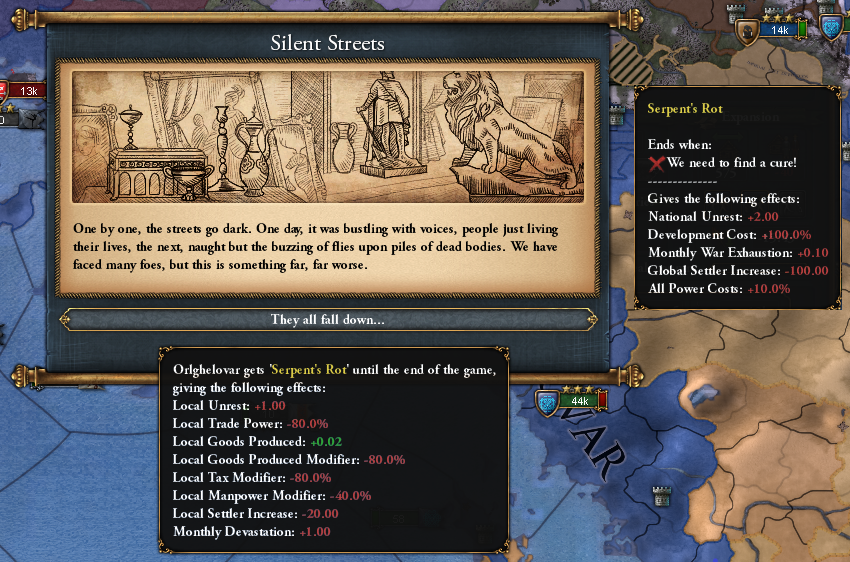 Lockdown begins The situation deteriorated very rapidly, and shortly after the group left Orlghelovar was locked down completely. Sick dwarves died in their beds, in the streets, at their workplaces, and they died choking on their own blood. The other races of the hold suffered equally, and the streets cleared as the population barricaded themselves inside their homes. Work ground to a halt, except for those on the local garrison who were ordered to enforce the lockdown and quarantine. It did not take long for the government to draw the line between the corpse at the base of the Mycos Caurak, giving the plague the name 'Serpent's Rot'.  Research funding and caring for the sick The members of the Assembly not trapped within the hold, and the Office of the President, were moved to Aqatbar to ensure the continued functioning of the government. They managed to maintain contact with the quarantine zone through the use of Sending Stones, and every voice within the hold called for all resources to be poured into finding a cure. The same call came from across the Union, as Viewcaught images of the dead and dying disseminated across the length of the Reach.  Ravelians among the artificers Life within the surface territory of the Union continued more or less as normal, though there was an undercurrent of worry and suspicion of any items sourced from the capital. The Ravelian Society stepped into this gap, bringing new and marvellous inventions made by Ravelian artificers in Cannor and gaining more influence within the field.  Focusing on the disease In the spirit of investigative science, those researchers still trapped within Orlghelovar proposed experiments on the sick in order to further progress towards a cure. The Rot proved almost universally fatal, and so there was nothing for the victims to lose by participating in the studies. Large areas of the Institute, having been closed to regular work, were turned into expansive wards for the sick where proper distancing between patient and doctor could be maintained and the progress of treatments could be monitored.  Push for the stone city The Escanni Wars of Consolidation appeared to be reaching their conclusion. Gawed had launched a campaign to defeat the two remaining contenders for victory, Corintar and Stalbór. Gawedi forces entered Castonath, the massive stone city that was once the capital of the Empire of Castanor, and it looked like even the power of Witch-Kings could stand up to the force the great northern power could bring to bear.  The first stop of the trip The glass study group toured the glass markets of Aqatbar and Deshkumar, and even some of the cities that sat on the tense frontlines between the three Great Powers that divided Bulwar. They confirmed that there was nothing in the techniques on display that could truly outshine Orlghelovar, at least in better times, but were more than happy to share dwarven techniques in the hope the Bulwari could find their own ways to improve them.  Outbreak Disaster struck, when one day the bloody remains of a dwarven engineer was discovered in a railyard just outside the entrance to Orlghelovar. It wasn't clear whether they had come from inside the city, or had caught the disease from a carrier who had travelled on the railway. Either way, the Rot was now outside the walls of the hold, and possibly spread all along the Reach via the rail lines. The order went out to shut down inter-hold trains immediately, but it was already too late. The Rot spreads from province to province, so in a way it is lucky that it first spawned in one of the far corners of the Serpentspine. It also doesn't spread to provinces outside the mountains, so we will be propped up by our surface cities throughout this. Much like the Obsidian Invasion, it pays to have places to fall back to.  Messages on the brain Ravelian artificers produced a competing product with Sending Stone in the form of the T-Wave Transceiver. Rather than requiring a paired object, this device allowed communication to anyone in the world at any time. However, it was viewed with significant suspicion by the general public who were concerned that it would allow the user to read minds as much as it would transmit to them. The military purchased a few samples for testing, but otherwise the Transceiver did not see much uptake by the Union. Extra mil mana is nothing to sniff at, but is also the most plentiful at this point so it is relatively low priority to find capacity for.  Rotten Blood Studies were no closer to discovering a cure, but researchers were getting more and more test subjects as cases sprang up along the length of the Reach. They had identified the exact cause of death, a literal rot that consumed the body starting in the blood, and with it a way of diagnosing the Rot in its earliest stages. It did not do much for those afflicted, but it allowed them to be quarantined before they could spread it. Lockdowns went into effect across all the holds of the Reach, and the mountains went silent as their inhabitants cowered in their homes.  The trip continues Across Cannor, from Estallen to Lorent to Damescrown, the study group met and shared knowledge with glassmakers. Still they were unable to find any techniques that surpassed those used in the Glass Hold. Curiously though, they did find that the conditions within the glass workshops were far more comfortable than those in the vast and imposing foundries of the mountains. Perhaps there was something to be learned from the attitude of the workers that would give the dwarves more room to innovate. 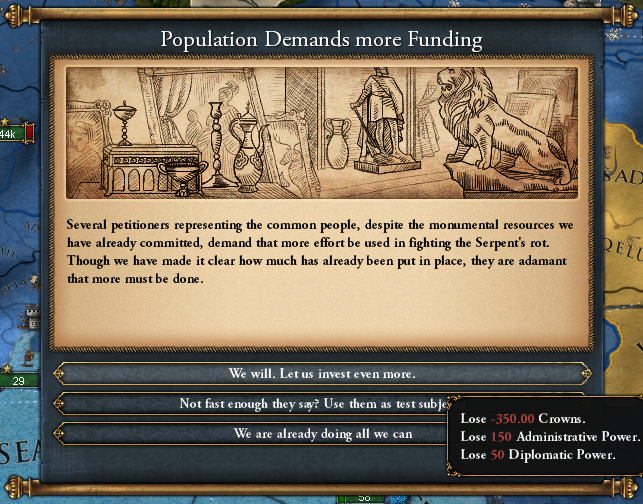 Pro-lockdown petition In spite of all efforts, bodies were piling up across the Reach. There were not enough dwarves to enforce lockdown conditions, and the population was starting to get desperate. Food riots were a regular occurrence outside of the major holds with reserves, which inevitably led to more spread of the Rot, and some dwarves simply gave up and travelled to spend their last days with their families. With society on the brink of collapse, local administrators pleaded with the central government to provide more support. It was never going to be enough, though. You get these sorts of events periodically throughout the disaster, demanding more funding or otherwise hitting your stability or producing rebels. Also, you have regular hidden events eating away at the development of your provinces as the population dies off.  Desperate experiments Studies into the disease grew more desperate, and scientists began to draw on Rot victims from across the Reach to ensure that they had enough bodies to continue their tests. Rail cars filled with the sick and dying rolled through the Reach towards Orlghelovar, while the inhabitants of the tunnels hid in their homes from the caravans of death. Such actions were not popular, but there was no ability for the populace to offer organised resistance as their sick family members were transported away as test subjects.  Techniques of cooperation The glass study group finally returned to Aqatbar, to a nation ravaged by the Rot. The surface was mostly safe, as the mountain holds had sealed their doors, but the damage to the economy was having a knock-on effect as merchants did not receive their goods, the supply of artifices had dried up, except from the Ravelians, and the banks centred on the holds had most shuttered their doors. However, the ideas that they had returned with did not necessarily need functional glassworks to implement. They were ideas of cooperation and innovation that the Glasslords that dominated Orlghelovar had mostly shunned even as other areas of the economy grew. If anything, this was the perfect opportunity to reset such attitudes.  Industrial investment Their ideas would require significant investment in the glass industry, including those industries in surface cities. The biggest parts of this would be bringing the glassworks up to modern standards, including artificer techniques in their operation, and working to break the monopoly the Glasslords had on production. Since the Rot gives a massive hit to developing, these missions showed up at just about the worst possible time.  Results, but not solutions Experiments continued, with blood samples from victims being examined and tested in every way possible to find a solution and cure for the Rot. The only beneficial discovery was that the disease could be purged by fire, but the government was not quite desperate enough to begin burning down the Reach to eradicate the Rot. That did not stop panicking residents burning down the homes of suspected Rot cases within their communities, or mass graves being converted to mass pyres by what authorities remained in the locked down holds.  In all aspects of Society The Ravelians were notable in that they did not further the growing dichotomy between mages and artificers, but rather embraced both disciplines as part of a greater whole. Many Ravelians were mages themselves, and their growing presence within the Mage Guild led the guild to focus more on internal debate and contemplation than politics and influence.  Safety of the labyrinth Ironically, one of the projects that did not stop during the Rot was the effort to expand the hold. With the miners and engineers in the depths, far away from the bulk of the population, they actually had a degree of separation and safety as long as they stayed away from the ruins of the Mycos Caurak. Behind them, the surviving inhabitants of the hold were moving into the structures that they carved out to spread out the population and contain the spread as much as possible.  Local efforts Besides the main governmental research into the Rot, many local administrators created medical systems of their own to treat the population and provide data. The Assembly approved funding for these local hospitals, as the more eyes were on the problem the greater the chance that someone would have a breakthrough.  A possible solution For months, scientists continued to be stumped, but it was in one of the smaller local research groups where a pattern was spotted in the data. The region was a more rural cavern, heavily overgrown with fungus. The Rot took far longer to establish a foothold, and the inhabitants took far longer to die from the disease. After extensive interviews and analysis of the bodies, categorised based on the rate of growth of their symptoms, the team was able to identify a common fungus that when consumed restrained the rotting of the blood. Samples were sent to Orlghelovar for further testing and possible synthesis of a cure.  Rise of the Ravelians While the inhabitants of the Dwarovar fought against the Rot, great changes were occurring on the surface. An announcement went out across the lodges of the Ravelian Society, calling all right-thinking peoples of the world to unite in worship and study of the singular and only God. Buoyed by the support the Society had provided to the commonfolk, millions eagerly joined the movement and soon they were calling upon kings and politicians to elevate Ravelianism within their lands. A number of Assembly members led by the Representative for Westend put forward a similar request, but when put to a vote by the rest of the Assembly it was voted down. The Union did not need to devote itself to a God to produce an egalitarian and scientific society. Here is where we would have converted if the vote had gone the other way.  Cannor converted While the Union's policies precluded mass-uptake of Ravelianism, the same was not true across Cannor. Facing popular uprisings, but also curious about the potential of centralized religion and the possibilities of artifice, many rulers willing converted and elevated Ravelianism to their own state religion. Most notable among these were the Kingdoms of Lorent and Gawed, the Union's long-time ally Estallen, and even the Wesdamerian Emperor. A few leaders still followed the Regent Court, either under Adean or Corin, but they were by far the minority. Larger still were masses of believers who now found themselves heretics within their own nations, but it remained to be seen whether that would cause graver issues. Dark grey hatched on light grey are Ravelian rulers over Regent Court provinces, and vice versa.  The heart of the faith Among the rulers of the Empire, the Marquis of Arannen was among the first to convert and offered some of his land for the Society to found territory ruled directly by them. Thus, the Ravelian State, the seat of the High Rectorate, was established. It was considered by many to be a strange choice, being on the edge of Ravelian influence rather than somewhere within the heart of the Empire, but President Whitebeard took it as a gesture of good faith and cooperation between the new religion and their fellow scientific travellers in the Union. Ravelian uses Catholic mechanics, with the High Rectorate acting as the Pope. The Council of Trent is replaced by a series of debates that define Ravelian's relationship with other religions, and they have a nice variety of pope-powers to choose from. Most notably is one that lets you add monarch skill (for a hefty price).  Militarization in the Dwarovar Belgar, now King after the untimely passing of his brother, had spent the past decade rebuilding and upgrading his military so that it would be able to stand up against that of the Union and secure his rightful place as ruler of the Aul-Dwarov. He demonstrated his strength by taking advantage of the religious upheaval, striking at Gawed, the otherwise uncontested strongest nation in the world. Dwarven forces marched through Escann and Gerudia, humiliating the Gawedi who were coming off the high of their conquests in Escann, and ultimately seeing a swathe of the northern pass coming back under dwarven control. Word was filtering in that the Rot was starting to spread in his territory, but he refused any offerings of assistance from Union scientists.  Moving too slowly Faced with endless reports detailing body counts across the Reach, word of outbreaks of the Rot in other dwarven nations, and the upheaval of the world order, President Whitebeard reached a point where he felt completely overwhelmed and powerless. He did not have the authority to take greater action, nor could he do anything to speed up the slow process of producing a cure. After years of dealing with the crisis, he took some time off to clear his head regardless of how that might appear to the Assembly.  Therefore, more decisive action is required It wasn't long before he returned, and Whitebeard brought with him fresh ideas on how best to cut through the red tape of the Assembly and ensure that the President had the necessary authority to take action during a crisis. Some in the Assembly expressed concern over the consolidation of power into the Presidency, but given that more than half the nation was dying or waiting to die the swathe of reforms granting more power to the President were passed. Finally, a proper fix for our absolutism issues.  Survival budget As a gesture of good will to his critics, one of Whitebeards first proposals was a slashing of the military budget, with an exception for fortification maintenance. The western border was friendly following the Ravelian conversion, the Union's main enemy in the north was engaged in a major war, which just left the two other powers in Bulwar as a threat. With the fortresses manned, any invasion by them should be delayed long enough to bring the army back to full strength. By cutting the military budget, a much larger portion of the government finances could be devoted to funding the research effort providing relief to those affected by the Rot and still trapped within their homes in the mountains. Our reliance on trade is really saving us here. Without it we would have to cut basically everything to the bone just to survive.  Consolidation of debts In return, the Assembly demonstrated surprisingly effective financial acumen by organising a series of consolidations and payment plans to reduce the burden of the debt that the nation was racking up while fighting the Rot. The President's new enthusiasm was clearly as infectious as the Rot itself.  The Wars end Despite its defeat at the hands of the dwarves, the Kingdom of Gawed remained the outright winner of the Wars of Consolidation. Swathes of Escann, including Castonath itself, lay in their hands and none of the Witch Kings wielded enough power to defeat them. Two centuries after overcoming the Greentide, a new era of foreign subjugation was beginning.  The ultimate sacrifice Research into a cure for the Rot seemed to be at an impasse. So far the fungus had been proven to help slow the spread of the Rot, but they had not found a way to prevent the victim from eventually dying, or confirmed that it could prevent the Rot spreading to someone previously uninfected. One of the scientists, Moirin Ettinkiller, took matters into his own hands and simultaneously consumed the refined fungus culture and a sample of Rotten blood. His death was slow and agonising, as the Rot ultimately claimed him, but his own notes taken over his long decline allowed the rest of the team to find the correct dosage of fungus to prevent the disease from spreading in the first place. In their hands, they held the cure.  A cure for all With a cure in the hands of the Union, some voices suggested that it should only be distributed within the nation. The Rot was the perfect opportunity to strike down the tyrant ruling in Orlazam-az-dihr. Those dwarves were drowned out by the rage of those who had seen their friends and family suffer and die at the hands of the disease. It was a curse that they would not wish on anyone, let alone the civilian population of a nation that just happened to be a rival of the Union. Instead, the cure was distributed through the ventilation system of the Dwarovar so that all inhabitants, dwarves or otherwise, could be freed from the Rot's grasp. The Serpent's Rot comes to an end. Honestly it is a bit less interesting than the Hoardcurse and Invasion. There is a lot of flavour early on, but it soon trails off and beyond a point you are just letting time tick over waiting for the 'Cure' event to pop while unable to do anything else because your nation is devastated. Still, it is appropriately devastating as a pandemic should be. If you ever are facing a powerful dwarven nation in the game, the Rot is the perfect time to break them. Taking the option to only distribute it to the capital is only good if you have a really small nation. Otherwise, it's really shooting yourself in the foot as you have to wait for the cure to spread from province to province rather than all your provinces getting the cure at once.  The Glass Hold revitalized As the Rot faded away, the gate of Orlghelovar were thrown open and for the first time in years citizens from inside and outside the mountains were able to meet. Families and friends reunited, the researchers who had saved the nation were rewarded, including posthumously, and goods began to flow once again. More than that came investment. Following the glass study group's tour of Bulwar and Cannor, the government had commissioned Karrom Greybeard to work on new glassmaking techniques, but he had required the vast glass foundries of Orlghelovar to complete his work. Now that access was open, the abandoned production lines could be restarted and a new generation of glassmakers could take up the task.  Restoring control It was not all happy reunions and economic miracles. Across the Reach, countless settlements had been abandoned, order had broken down, and local administrators were dead or missing. In these dire times, the only way to restore order was through force. Martial law edicts went out across the length of the mountain range, and slowly the military began to restore order, safety and productivity to the areas worst hit by the Rot. I don't normally find much use for this state edict in vanilla EU4 but when your entire nation is completely devastated it is actually pretty useful.  Cannorian charity The arrival of no-strings-attached funds from Damescrown were very welcome. The plight of those affected for the Rot had struck a chord in those with charitable instincts and while most of their donations were too small to make a dent occasionally something came through from a person of high status or wealth that actually moved the notch on the debt that the Union had built up.  The spoken word, heard nationwide One of the new machines produced by the artificers was the Crierless Crier, capable of repeating an audio message and also magically enhance its volume to allow the words to be heard across a city. These were carried along by the squads restoring order to Reach, each one speaking a message from the President himself thanking the survivors for holding out, and promising them that the government would be doing everything it could to rebuild their society. For this I swap out Self-Cleaning Parchment. We need the diplo power to help develop provinces for the mission more than we need a bit of Adm Eff.  Artificers taking charge The government was continuing to invest a lot into glass production research, and this was causing conflict between the artificer guild and the Glasslords who dominated the glass trade. Greybeard's discoveries were getting slow uptake among the cartels, while the artificers were rushing ahead to build devices and inventions that made use of them. Ultimately, and to the Glasslord's displeasure, the government sided with the artificers, interested as they were in new developments.  Opportunity to intervene While the nation was focus on repairing itself, an interesting report came in via Sending Stone to the President's desk. Kheterata and Bhuvauri, a powerful nation in Rahen, had joined together for a joint invasion of the Phoenix Empire. This was a battle that could very well decide the fate of Bulwar, and so staying out of it might not be an option. Whitebeard, cautious as he was, sought his advisors' opinions as to exactly how the Union should get involved, a decision that might shape the future of the region. To be continued… Vote The President is faced with a choice. The Unions two great rivals in Bulwar are at war, and based on their performance in past conflicts the Phoenix Empire is almost certain to grievously lose. The Union can intervene on their behalf (or rather start a separate war against the Khet so we can take what we want) or it can join against them to finish the liberation of the Deepwoods and the Harpy Hills. Targeting one or the other will focus our foreign policy goals for years to come. The other option is to deal with internal matters first, considering that there is still considerable debt to be repaid from the Rotten Years and scientific missions to complete. Please vote for one option: A: Focus on Kheterata – We cannot allow them to continue expanding lest they grow to the point their quantity can beat our quality. Long-term we will aim to push them out of Bulwar entirely and trap them in their Sarhali territory. B: Focus on the Phoenix Empire – We cannot let the opportunity pass to deliver a crushing blow to our long-time rivals. Long-term we will aim to secure the holds of the Middle Dwarovar that they currently occupy. C: Focus on neither – Focus on the rebuilding and repayment efforts, and only intervene once the country and economy are stable. Long-term, take on targets of opportunity to expand. Note that focusing on one will not mean that we will ignore the other, but the other is likely to be limited to just border clean up and strategic/access conquests. Voting will last 48 hours.
|
|
|
|
Can't trust either of them! C
|
|
|
|
B, those occupied holds are an insult that should have been addressed a century ago, but the second-best time is now.
|
|
|
|
Crazycryodude posted:B, those occupied holds are an insult that should have been addressed a century ago, but the second-best time is now. B for exactly the reason you stated! Dwarven holds and dwarven railroads belong in dwarven hands!
|
|
|
|
A
|
|
|
|
Crazycryodude posted:B, those occupied holds are an insult that should have been addressed a century ago, but the second-best time is now.
|
|
|
|
All of this could have been avoided if people had just washed their hands B
|
|
|
|
Crazycryodude posted:B, those occupied holds are an insult that should have been addressed a century ago, but the second-best time is now. Strike the enemy in our rightful earth!
|
|
|
|
B
|
|
|
|
Crazycryodude posted:B, those occupied holds are an insult that should have been addressed a century ago, but the second-best time is now.
|
|
|
|
B. Get them holds back!
|
|
|
|
NewMars posted:B. Get them holds back!
|
|
|
|
B. Give me holds or give me death!
|
|
|
|
B. Holds! And if while we free the holds, we should happen to find more of the gems, so much the better!
|
|
|
|
Rody One Half posted:B. Holds! For reference, the Phoenix Empire does hold one of the gems, but taking it will cost a lot of warscore so it's a lower priority than just taking territory. The other gems are mostly in the hands of Khugdihr, who are our ostensible allies against Orlazam-az-dihr. Perhaps we can snipe the gems from them at a later point, but the vote taken a while ago was for us to focus on the surface rather than conquering our fellow dwarves.  It seems like B is almost the unanimous choice, so I will close the poll early if one of the other options doesn't have a comeback by later today.
|
|
|
|

|
| # ? May 29, 2024 05:01 |
|
Sybot posted:For reference, the Phoenix Empire does hold one of the gems, but taking it will cost a lot of warscore so it's a lower priority than just taking territory. The other gems are mostly in the hands of Khugdihr, who are our ostensible allies against Orlazam-az-dihr. Perhaps we can snipe the gems from them at a later point, but the vote taken a while ago was for us to focus on the surface rather than conquering our fellow dwarves. 40% is not a LOT of warscore to get the gems
|
|
|






